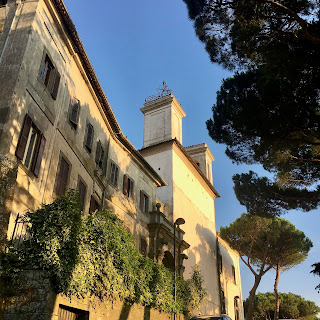Montefiascone 2020
"We've been holding on and hoping, but with so many unknowns, we have, with heavy hearts, decided to cancel the summer 2020 programme. These last months have been especially hard for Italy and though Montefiascone is a small country town, and doing better than many, it faces the same difficulties and fears as us all. We wish them and all of you hope and courage to get through this terrible time and we look forward to seeing you in the summers to come."
Cheryl Porter, Director
The programme for this year's Montefiascone Conservation Project has just been published. I am delighted to be offering a course in the final week this year, 'A Chinese Qur'an.'
To sign up, costs are £550 (or euro equivalent) for each week and include all lectures, which are in English. For more information and to enrol, contact Cheryl Porter,
Week 1: 27th-31st July
Recreating the colours on the Medieval palette: Western, Hebrew and Islamic.
This class will study the colours (made from rocks, minerals, metals, insects and plants) that were processed to produce the colours used by artists throughout the medieval era. The focus will be on manuscript art – Islamic, Hebrew and European. Participants will re-create the colours using original recipes. Illustrated lectures will address history, geography, chemistry, iconography and conservation issues. Practical making and painting sessions will follow these lectures. No previous experience is necessary.
Week 2: 3rd-7th August
Early nineteenth century American and English bookbinding: machines, materials, structures, and tools.
In England and America, common book structures changed significantly during the early nineteenth century. A typical inexpensive calf or sheep binding was supplanted by even cheaper, new binding styles, such as paper boards bindings and the three-piece adhesive cloth case. In industrial binderies, the plough was replaced by two quicker machines, the guillotine and the board shear. The way binders worked, and viewed their work, also changed drastically.
We will examine this time period through powerpoints, readings, discussions, and the hands-on construction of four models: an English common-boards binding, an American extra-boards binding, an American tight-back cloth binding, and an English adhesive cloth case. We will explore methods of replicating plain and textured nineteenth century bookcloth, starting with undyed muslin. Close readings from bookbinding manuals, analysis of bindery images, and the use of historic tools will enhance our understanding of this important time period. Often these binding styles are referred to as "temporary" and we will debate some conflicting evidence and definitions of this term. By the end of the nineteenth century, the cloth case became ubiquitous worldwide. This workshop will equip participants to better understand, interpret, and sympathetically treat nineteenth century books they encounter.
Week 3: 10th-14th August
Recreating a late sixteenth-century Cambridge bookbinding
Cambridge, heavily influenced by its university, has always been a place with books at the heart of its activities; a place where they have for many centuries been printed, sold, bound, owned, stored, read and used. Our Montefiascone course, a few years ago, was devoted to making a model of a late 15th century Cambridge binding; this year we will analyse a binding style from a century later and construct a model of a typical late 16th century Cambridge binding. At the end of the 15th century, leather-covered bindings usually had wooden boards and clasps and decoration depended on labour-intensive repetitive tooling using small hand-held tools. A century later, wood had given way to pasteboard or pulpboard, clasps had been replaced by cloth ties and decoration looked very different; gilt tooling, unknown in English binding work before about 1520, had become common.
Week 4: 17th-21st August
A Chinese Qur’an
During this class, participants will make a model of Chester Beatty Is 1602, a 17th or 18th century Chinese Qur’an with its original binding. This small manuscript is distinctly Chinese. It is covered with fine patterned silk, and the pages are made of soft, fibrous, Chinese paper. In keeping with many Islamic bindings, it has an envelope flap, but this is squared off, similar to those seen in some south-east Asian Islamic manuscripts. This Qur’an is an example of how aspects of the Islamic book were combined with local decorative traditions influencing ornament, calligraphy and illumination.
According to the historical accounts of Chinese Muslims, Islam was first brought to China by Sa'd ibn abi Waqqas, in 651. Although scholars have not found any historical evidence that he visited China, they agree that the first Muslims must have arrived in China in the 7th century, and that the major trading cities, such as Guangzhou, Quanzhou probably already had their first mosques built during the Tang Dynasty. Muslims in China have continued to practice their faith sometimes under very difficult circumstances. Today, the Muslim population of China is estimated as representing 0.45% to 2.85% of the total population with 39,000 mosques serving this congregation. This Qur’an represents the Islamic legacy in China and is a unique opportunity to examine this combination of traditions which were carried along the Silk Roads over the centuries.



Comments
Post a Comment